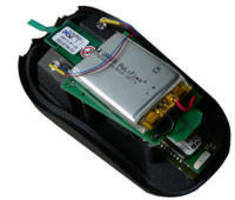Vision and Imaging Sensors / Detectors
Sensor Hardware enables non-contact color measurement.
Share:
Press Release Summary:

Model MTCS-FB1 is based on True Color sensors and provides XYZ color measurements repeatable to within 1% accuracy. OEM unit provides measurement area of 30 mm, with white-light LEDs as standard light sources, and includes Bluetooth, USB, or RSxxx interfaces. Sensor signals have resolution of 12 bits at 0.1 kHz center measurement frequency, enabling triggering tolerance of 0.2 mm. Power supply, 2 LEDs, and 2 color sensors utilizing MTI04 amplifier are included.
Original Press Release:
Non-Contact OEM Color Measurement with JENCOLOR
Jena, Germany, 28 January 2009 - As part of its JENCOLOR range of function boards, MAZeT GmbH is introducing several new solutions and OEM systems for hand-held applications. The new MTCS-FB1 sensor hardware, based on MAZeT's True Color sensors, provides non-contact color measurement with system interfaces such as Bluetooth, USB, or RSxxx. The sensor system provides XYZ color values (DIN5033 / CIE1931 color space). Once the measurements are calibrated to a repeat accuracy of <1%, the system provides absolute accuracies that are better than the human eye (Delta E <2). The absolute accuracy attained through serial measurement relies on system calibration as well as the chosen light source. Thanks to the sensors' long-term stability, periodic sensor calibration is not needed for ongoing operation after the initial factory calibration. MAZeT also offers customized designs with alternative interfaces and color filters.
White-light LEDs are used as the standard light source in the sensors.
Alternative light sources can also be implemented to meet the customer's application-specific requirements. For the specification stage, MAZeT recommends the use of JENCOLOR simulators, which simulate the interplay of light source, sensor, color target and calibration to achieve the accuracy required by the customer. The system can thus be reliably configured and optimized right from the outset. This avoids post-development modifications and shortens the time-to-market.
Test lighting employs two white-light LEDs, which are aligned near-parallel to the sensor direction (Sensor 1). This means the lighting and measurement take place at a vertical angle to the sample.
Such an optical-axial system facilitates non-contact measurement at variable distances. The optimal measurement range depends on the specific application and the physical factors (object, surface, light source, measurement period, etc.). The standard version of the unit provides a measurement area of approx. 30 mm. In order to ensure reproducible results at all times, the sensor is fitted with a distance detector. This is based on a second color sensor, which is offset from Sensor 1. Sensor 2 ensures that the color signal can always be analyzed when the specified measurement distance between the sensor and the object is detected. This distance in the sensor system is calculated from the offset angle between the two sensors and from the distance between the two sensors on the board.
The sensor signals have a resolution of 12 bit at a center measurement frequency of 0.1 kHz. This means that the measurement's triggering tolerance (approach accuracy at a typical hand speed of approx. 2 cm/s) is 0.2 mm. The distance and tolerance parameters may be modifiable in future versions.
Alternatively, in cases where the measurement is not used to analyze the brightness of the application but only the XY color space, the approach distance does not need to be measured.
Depending on the selected amplification level, both color sensors supply continuous, independent measurement signals. Because the sensor employs MAZeT's own MTI04 amplifier, a total of 8 amplification levels are possible (steps ranging from 25 kOhm to 20 MOhm). The levels are suitable for the amplification of signals ranging from 25 nA to 20 µA.
The µc takes care of controlling the amplification levels, the signal handling, control functions and communication. The µc's firmware continuously outputs the measurement values of the two sensors via the system interface to the master, which is a PC. The measurement importing functions, calibration routines, colorimetric calculations and a monitoring application are contained in a .DLL and the test software, both of which are part of the SDK supplied with the sensor. By taking advantage of the provided routines, the customer can therefore focus on developing the actual application software and implementing the sensor. As well as the sensor unit, µc, software, and interface, the system also includes a power supply (chargeable adapter providing 12 hours of regular operation without recharging), two buttons (on/off, mo-di), and two LEDs (status, operating mode). These are located on the sensor system's function boards.
Once calibrated, the OEM sensor system delivers absolute tristimulus color measurements that are highly precise, display excellent repeat accuracy, have no deviation, and are based on specifiable distances. The second on-board sensor additionally enables the detection of surface qualities and reflectivity on the measurement object. The OEM software shipped with the unit provides the customer with all the necessary routines, ranging from the ADC value to the color space of the testing environment. To sum up: The MTCS-MF1 is a powerful OEM device that customers, particularly product developers, can quickly integrate into a final product - all that's needed is a case and a user software.
About MAZeT
MAZeT GmbH is a leading European development and production service provider. The company, founded in 1992 with headquarters in Jena, develops, manufactures and delivers customer-specific electronic modular units, software and ASICs, and markets its own products under the name JENCOLORTM worldwide. Due to its broad technological offerings and application know-how, MAZeT GmbH is a dependable and proven service partner for made-to-measure, customer-specific solutions in the areas of industrial electronics and optical sensors. The company's development competence and the components produced by it for special uses can be found in the whole area of industrial measurement technology, control engineering, automation and medical areas, among others. For more information please see http://www.mazet.de/index_html?set_language=en&cl=en.




